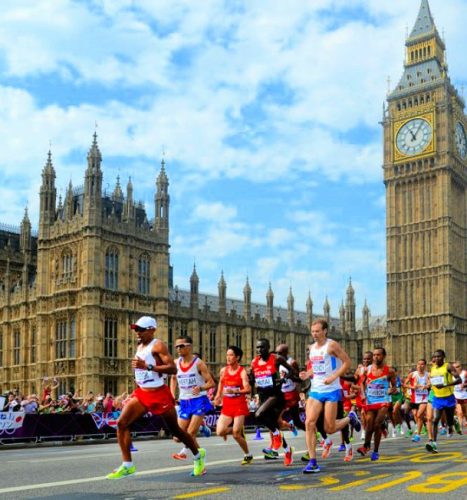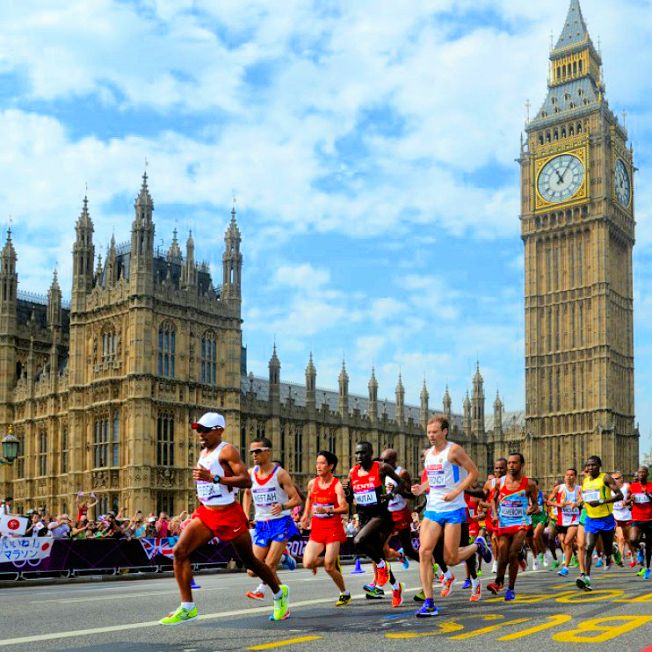
The London Marathon, an article that explains the history of this kind of race, with its main protagonists, founders, sponsors, charities and cultural features.
The marathon’s name and distance date back to the ancient story of a Greek soldier. As a matter of fact, according to Herodotus, an Athenian runner named Pheidippides was sent to run from Athens to Sparta to ask for assistance before the battle. He ran a distance of over 225 kilometers (140 miles), arriving in Sparta the day after he left. Then, following the battle, the Athenian army marched the 40 kilometers (25 miles) or so back to Athens at a very high pace (considering the quantity of armour, and the fatigue after the battle), in order to head off the Persian force sailing around Cape Sounion. They arrived back in the late afternoon, in time to see the Persian ships turn away from Athens, thus completing the Athenian victory.
Later, in popular imagination, these two events were conflated, leading to a legendary but inaccurate version of events. This myth has Pheidippides running from Marathon to Athens after the battle, to announce the Greek victory. The Marathon-to-Athens distance is actually slightly less than 40 km (25 mi). This was the distance used at the first modern Olympic Games, held in Athens in 1896. The marathon there was won by Greek runner Spiridon Louis with a time of 2 hours 58 minutes 50 seconds. The following year the first Boston Marathon was held, as it has every year since.
The marathon is traditionally the final event at modern track and field competitions, including those at the Olympic Games. Annual marathons have gained popularity, and races in major cities such as Boston, Los Angeles, and New York, shown here, attract thousands of runners. Marathon (sport), running event, traditionally the longest race (42 km, 195 m/26 mi, 385 yd) included in track-and-field competitions. It is traditionally the final track-and-field event held at the Summer Olympic Games. Marathons have become increasingly popular around the world, and the larger events – such as races held in Boston, Massachusetts; London, England; Berlin, Germany; and New York City – attract thousands of runners and spectators annually.
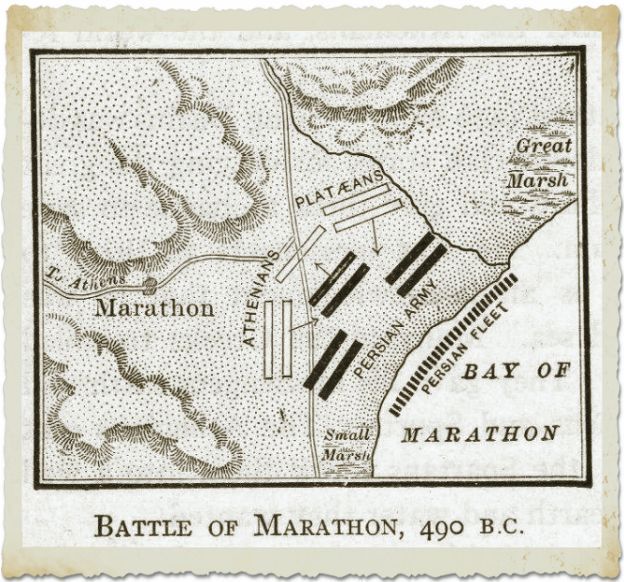
The first marathoner to repeat as Olympic champion was Ethiopian Abebe Bikila, who captured gold medals in 1960 and 1964. Bikila ran barefoot in his first Olympic win, setting a new world-best time of 2 hours 15 minutes 16.2 seconds (because each course is different, there were no official world records for the marathon until a course certification program was created in 2004). American Frank Shorter increased the popularity of the event in the United States when he won the marathon at the 1972 Olympics. Waldemar Cierpinski of East Germany matched Bikila’s achievement with consecutive Olympic wins in 1976 and 1980.
The African nations of Kenya and Ethiopia have emerged as the leading producers of great male marathoners. Ethiopia’s tradition goes back to Bikila in the 1960s, while Kenya first became a force beginning in 1988 when Ibrahim Hussein captured the first of his three Boston Marathon titles. Kenyan runners – such as Hussein, Joseph Chebet, John Kagwe, Cosmas Ndeti, and Moses Tanui – won every men’s Boston Marathon but one from 1991 to 2004, along with five New York City Marathons from 1997 to 2004. Some experts attribute this trend to the higher elevations at which these runners train in their home countries. Top marathoners from other countries have responded by also training extensively at high elevations.
The London Marathon is an annual marathon held in London, United Kingdom. Founded by athletes Chris Brasher and John Disley in 1981, it was typically held in April but has now moved to October. The largely flat course is set around the River Thames, starting in Blackheath and finishing at The Mall. Hugh Brasher (son of Chris) is the current Race Director and Nick Bitel its Chief Executive.
The race has several components: it has a mass race for the public, professional races for men and women long-distance runners, elite level wheelchair races for men and women, plus a 3-mile mini marathon event for under-17 athletes. The mass race is the largest marathon event in the United Kingdom and its third largest running event (after the Great North Run and Great Manchester Run). There is a significant charity running aspect to the marathon, with participants helping to raise over £1 billion since its founding, including £66.4 million at the 2019 London Marathon which was the highest amount for a single-day fund-raising event.
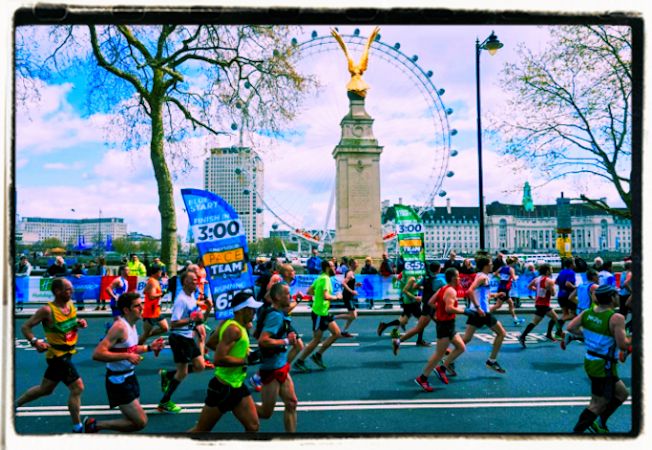
The 2022 London Marathon will take place on Sunday, 2 October as the event is moved from its traditional April date for a third successive year. Event director Hugh Brasher confirmed the race has been moved to allow for the “best chances” of a full-capacity event, including crowds. The course begins at three separate points: the ‘red start’ in southern Greenwich Park on Charlton Way, the ‘green start’ in St John’s Park, and the ‘blue start’ on Shooter’s Hill Road. From these points around Blackheath at 35 m (115 ft) above sea level, south of the River Thames, the route heads east through Charlton. The three courses converge after 4.5 km (2.8 miles) in Woolwich, close to the Royal Artillery Barracks.
As the runners reach the 10 km mark (6.2-mile), they pass by the Old Royal Naval College and head towards Cutty Sark drydocked in Greenwich. Heading next into Deptford and Surrey Quays/Rotherhithe in the Docklands, and out towards Bermondsey, competitors race along Jamaica Road before reaching the half-way point as they cross Tower Bridge. Running east again along The Highway through Wapping, competitors head up towards Limehouse and into Mudchute in the Isle of Dogs via Westferry Road, before heading into Canary Wharf.
As the route leads away from Canary Wharf into Poplar, competitors run west down Poplar High Street back towards Limehouse and on through Commercial Road. They then move back onto The Highway, onto Lower and Upper Thames Streets. Heading into the final leg of the race, competitors pass The Tower of London on Tower Hill. In the penultimate mile along The Embankment, the London Eye comes into view, before the athletes turn right into Birdcage Walk to complete the final 352 m (385 yards), catching the sights of Big Ben and Buckingham Palace, and finishing in The Mall alongside St. James’s Palace. This final section of the route formed part of the 2012 Olympic Marathon Course.
Since the first marathon, the course has undergone very few route changes. In the first race, the course took a diversion around Southwark Park before re-joining Jamaica Road on the way to Tower Bridge and was routed through St Katherine Docks past the Tower Hotel, en route to the Tower of London and the cobblestoned stretch of road that in later years was carpeted, to help runners prevent injury on the uneven surface.

In 1982, the finishing post was moved from Constitution Hill to Westminster Bridge due to construction works. It remained there for twelve years before moving to its present location at The Mall. In 2005, the route around the Isle of Dogs between 22 and 34 kilometres (14 and 21 mi) was switched from a clockwise to an anti-clockwise direction, and at 35 km (22 miles) the route was diverted to avoid St Katherine Docks and the cobblestoned area near the Tower of London. In 2008, a suspected gas leak at a pub in Wapping diverted the course, but in 2009 the race followed the same path as in 2007.
Since 2006, the elite race has been part of the World Marathon Majors, which includes six of the world’s top level marathon races. The London Marathon has seen the marathon world record broken on seven occasions: Khalid Khannouchi broke the men’s record in 2002, while women’s records have been broken by Grete Waitz (1983), Ingrid Kristiansen (1985), Paula Radcliffe (2002, 2003, 2005) and Mary Jepkosgei Keitany (2017). The current elite course records are held by Eliud Kipchoge (2:02:37 in 2019) and Paula Radcliffe (2:15:25 in 2003). The current wheelchair course records are held by Marcel Hug (1:26:27 in 2021) and Manuela Schär (1:39:52 in 2021).
Since 2012 mile 21 has become a significant cheer zone with Run Dem Crew transforming the stretch of Commercial Road outside the former Limehouse Town Hall into a street party with music and confetti cannons. Due to the COVID-19 pandemic, the 2020 London Marathon was run on a non-traditional course, consisting of 19.6 laps of length 2.15 kilometres (1.34 mi) around St James’s Park, taking in The Mall, Horse Guards Parade, Birdcage Walk and Buckingham Palace. The final circuit was 1,345 metres (0.84 mi) along the Mall, following the finish line of the traditional London Marathon course.
The marathon is run over a largely flat course around the River Thames, and spans 42.195 kilometres (26.219 mi). The route has markers at one mile intervals. Although the race publicity (athlete advice, timing charts and so on) is mile-oriented,the individual timing splits that are available to competitors after the event are kilometre-oriented.
The first London Marathon was held on March 29, 1981. The women’s world marathon record of 2:21:06 was set in 1985 on the London course by Norway’s Ingrid Kristiansen. The course is 42 km long. From 1981 to 1997 a total number of 352,748 runners have finished the race. There are 23 water stations along the course of the run. There are 500 portable toilets on the route. In 1997 a record number of 41,288 runners were accepted; 29,600 began the race, 29,135 finished it. On average more than 100,000 applications are received but usually only 40% of the people choose to run the race. People who want to compete in the Marathon have to fill in an application form that can be obtained through the Asics Sports shop chain.
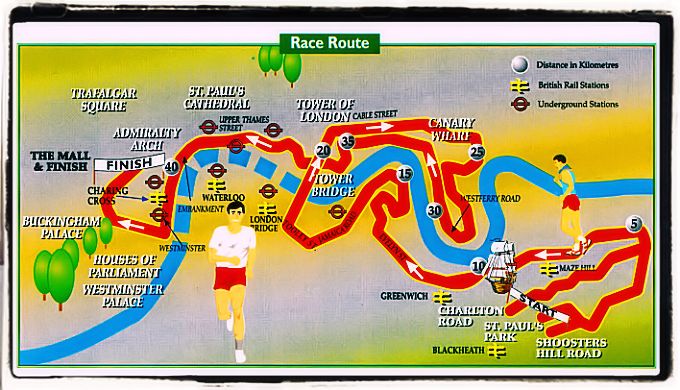
The 2020 London Marathon was postponed and only allowed elite participants due to the COVID-19 outbreak. The race often has a title sponsorship, sponsored by Virgin Money for several years, it is branded the “TCS London Marathon” for 2022. There are three separate groups of starters: Elite Women, Wheelchair (Men and Women), and Elite Men followed by Mass Race.
The London Marathon was not the first long-distance running event held in the city, which has a long history of marathon events. The Polytechnic Marathon (also known as the Poly) was first held in 1909. The current London Marathon was founded in 1981 by Olympic champion and journalist Chris Brasher and athlete John Disley and it was s held on 29 March 1981, more than 20,000 applied to run. 6,747 were accepted and 6,255 crossed the finish line on Constitution Hill.
The Marathon’s popularity has steadily grown since then. As at 2009, 746,635 people have completed the race since its inception. In 2010, 36,549 people crossed the line, the biggest field since the race began. The first wheelchair marathon race was held in 1983 and the event was credited with reducing the stigma surrounding disabled athletes. In 2013 the IPC Athletics Marathon World Cup was held within the London Marathon featuring athletes of both genders in the T42–T46 and T11–T13 categories. In August 2013 it was announced that the event would be staged in London until 2017 and feature athletes in the T11-T12, T13, T42-T44, T43, T45-46, T51-52 and the T53-54 class.
For many years the London and Polytechnic Marathons competed with each other until, in 1996, the latter folded in due to the popularity of the former. Following the Boston Marathon bombing, organisers of the 2013 London Marathon undertook a review of their security arrangements, despite no specific threats against the event. A 30-second silence was held before the start of the marathon to show respect and support to those affected by the tragedy. The race is currently organised by Hugh Brasher, son of Chris, the co-founder of the Marathon, as Race Director and Nick Bitel as Chief Executive. Previously David Bedford and Bitel had overseen a period of great change for the race, including amendments to the course in 2005 which saw the cobbled section by the Tower of London replaced with a flat stretch along the Highway.
Dan Tunstall Pedoe was the medical director of the London Marathon for 25 years between the first one in 1981 until 2005. In 2003, Pedoe was shadowed by Sanjay Sharma from St George’s Hospital (University of London) who took over the role in its entirety in 2006. Medical cover is provided by 150 doctors. Also assisting were more than 1,500 volunteers of St. John Ambulance, who organise over 50 first aid posts along the route, and three field hospitals at the finish. St John Ambulance also provide a number of healthcare professions for the event, including nurses, paramedics, ambulances with crews.
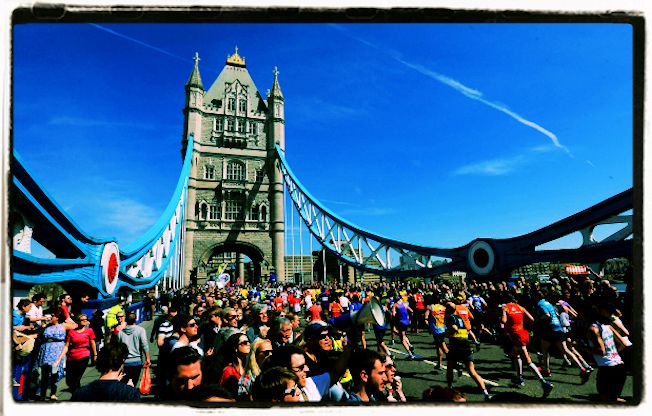
London is one of the top six world marathons that form the World Marathon Majors competition with a million prize purse. The inaugural marathon had 7,741 entrants, 6,255 of whom completed the race. The first Men’s Elite Race in 1981 was tied between American Dick Beardsley and Norwegian Inge Simonsen, who crossed the finish line holding hands in 2 hours, 11 minutes, 48 seconds. The first Women’s Elite Race, also in 1981, was won by Briton Joyce Smith in 2:29:57. In 1983, the first wheelchair races took place. Organized by the British Sports Association for the Disabled (BASD), 19 people competed and 17 finished. Gordon Perry of the United Kingdom won the Men’s Wheelchair Race, coming in at 3:20:07, and Denise Smith, also of the UK, won the Women’s Wheelchair Race in 4:29:03.
World records for marathon running have been set several times. Khalid Khannouchi, representing the United States, set the men’s world record in 2:05:38 in 2002. The following year, British runner Paula Radcliffe set the women’s world record in 2:15:25 (later briefly downgraded to “world best” by the IAAF as it was achieved in a mixed race, but restored to the title of “world Record” shortly thereafter); in 2017 Mary Keitany of Kenya set a world record of 2:17:01 for an all-women’s marathon. Previous women’s world records were set in 1983 and 1985 by Grete Waitz and Ingrid Kristiansen respectively, both of Norway. The current men’s course record is 2:02:37 set by Kenyan Eliud Kipchoge in 2019. Marcel Hug of Switzerland set the Men’s Wheelchair Race course record at 1:26:27 in 2021, and the Women’s equivalent was set by Swiss athlete Manuela Schär in 2021, with 1:39:52.
For many, it is the culmination of months of hard work and training. A morning run, often as much as ten miles, and an evening at the gym will not have been unusual. They’re determined to be in peak physical form for the big day on Sunday, 26th April. For others, preparation for the Marathon has not been so arduous. Maybe they’ve had to sew the ears onto their rabbit costume or stick some more feathers onto their chicken outfit And then they’ve had to collect all those signatures from the people who are going to sponsor them so they can raise money for their good cause. The London Marathon is an extraordinary event.
Part serious competitive sporting contest, part good humoured silliness, it attracts all sorts of people from all walks of life. There is the Elite Race, with big-named athletes from all over the world competing against each other. There is the Wheelchair Marathon, organised by Disability Sport England, with wheelchair-bound athletes powering themselves around the course. Then there is the Mini-Marathon, open to children between the ages of 11-17, who compete on a modest four and a half kilometre run. And then there is the Mass Race, with tens of thousands of individuals of all ages and abilities trying to complete the 42 kilometre course from Blackheath in south-east London to the Mall near Buckingham Palace, as quickly or as absurdly as they can.
The race attracts amateur runners who make up the bulk of the thirty thousand or more participants; commonly running in fancy dress for charity causes. In 2002, Lloyd Scott completed the marathon wearing a deep sea diving suit that weighed a total of 110 lb (50 kg), with each shoe weighing 24 lb (11 kg); he also set a record for the slowest London Marathon time. On 19 April 2003, former boxer Michael Watson, who had been told he would never be able to walk again after a fight with Chris Eubank, made headlines by finishing the marathon in six days. In 2006, Sir Steve Redgrave (winner of five consecutive Olympic gold medals) set a new Guinness World Record for money raised through a marathon by collecting £1.8 million in sponsorship. This broke the record set the previous year by the founder of the Oasis Trust, Steve Chalke, who had collected over £1.25 million. In 2011, Chalke raised a new record £2.32 million. The £500 that Claire Squires collected before the race increased to over £1 million after she died having collapsed during the 2012 race.
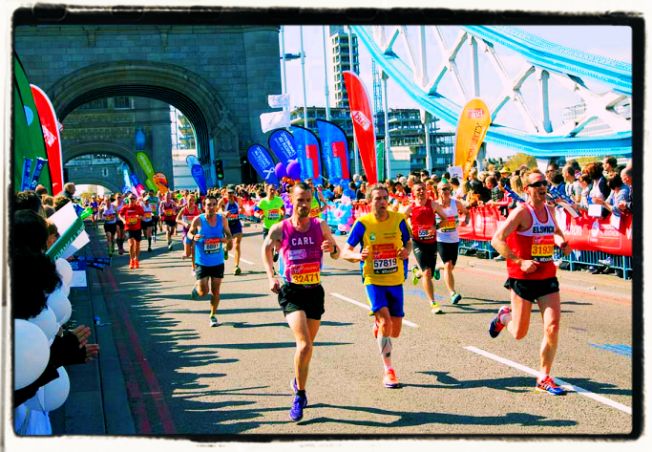
For many of the thousands who line the route of the race, or the millions more who watch it on TV, it is the sporting prowess of the competitors that is the main attraction. They cheers champion runners, like Portugal’s Antonio Pinto and Kenya’s Joyce Chepchumba, and are thrilled when records are broken.
But for the majority of spectators, it is not the best athletes who interest them, it is the silliest. Since the very first London Marathon in 1981, when the most noticeable costumed runner was a wafter who carried a tray with a bottle of mineral water over the course, a myriad of crazy and outrageous costumes have been worn on the race. There has been Mickey and Minnie Mouse, Superman and Winnie the Pooh. A policeman ran as a bishop, complete with robes, mitre and staff. He was raising money for a children’s hospice. A team of six men and four women ran dressed as rhinoceroses to raise money to help preserve endangered species.
Each year two official charities are nominated by the organisers – in 1998 for instance it was the Diana, Princess of Wales Memorial Fund and Age Concern. The Charity of the year for 2022 help to heal hearts by running the TCS London Marathon in support of the British Heart Foundation. These non-profit organizations can more-or-less guarantee themselves a donation of £5 million or more. But dozens of other charities also benefit from the event through the sponsorship of individual runners. And, despite the hardship of running across London in an outrageous costume, there is little doubt that the competitors enjoy themselves. There is a real carnival atmosphere all along the route with runners laughing, dancing and, only occasionally, falling over.
The BBC covers the event, devoting rolling coverage for most of the morning. The theme music associated with this coverage, and with the event itself, is called “Main Titles to The Trap”, composed by Ron Goodwin for the film The Trap.
The original sponsors of the London Marathon were Gillette, who sponsored the event from 1981 to 1983. Subsequent sponsors have been Mars (1984–1988), ADT (1989–1992), NutraSweet (1993–1995), and Flora (1996–2009). The current sponsors, Virgin Money, have sponsored the marathon since 2010, after signing a five-year £17m sponsorship deal in 2008. In April 2013, the London Marathon renewed its sponsorship deal with Virgin Money for a further five years and the race changed its name to the Virgin Money London Marathon. In 2021 it was announced that Indian consultancy company Tata Consultancy Services will take over sponsorship of the London Marathon from 2022. A number of other companies and organisations also use the event for brand identification and marketing, including New Balance, Lucozade Sport, and Fuller’s Brewery.
You can also read:

